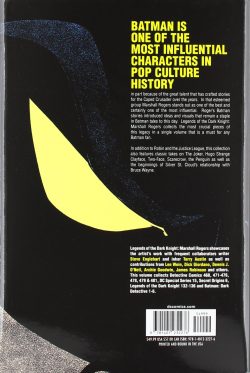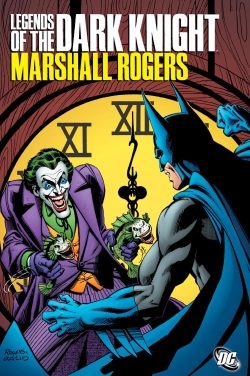

By Marshall Rogers, Bob Rozakis, Steve Englehart, Dennis J. O’Neil, Roy Thomas, Archie Goodwin, James Robinson, Terry Austin & various (DC Comics)
ISBN: 978-1-4012-3227-6 (HB)
Win’s Christmas Gift Recommendation: Timeless Bat-Magic… 10/10
William Marshall Rogers (January 22nd 1950 – March 24th 2007) was a true but quiet giant of comic books. He was born in Flushing, Queens region of New York City and attended Kent State University in Ohio (yeah, that Kent State) where he trained as an architect.
He afterwards worked lots of menial jobs – both inside the arts industries and the real world – before his first work was published, and that only after years of trying, getting close and resolutely trying harder and always getting better at his craft. He was first published in Marvel’s Deadly Hands of Kung Fu magazine after which he got his big break at DC under editor Julie Schwartz, doing superhero back-up strips in prestigious title Detective Comics.
That led to work on Batman and a fortuitous pairing with high-level Marvel defector Steve Englehart in 1977.
A period of pure magic resulted and the creators would reunite regularly thereafter: on Mister Miracle, Madame Xanadu (DC first direct sale title), Eclipse’s I am Coyote, Scorpio Rose and Marvel’s Doctor Strange and Silver Surfer, as well as Batman sequel series Dark Detective.
In 1989, he was the first artist for the revived Batman newspaper strip (from November 6th until January 21st 1990.
Always in demand, Rogers worked on countless features for many companies over the years but was at his boldly experimental best drawing Howard the Duck and G.I. Joe, adapting Harlan Ellison’s Demon With a Glass Hand (1986) and illustrating Don McGregor’s noir thriller Detectives Inc.: A Remembrance of Threatening Green. Perhaps his most personal contribution was his own charming fantasy Cap’n Quick and a Foozle…
Although his contributions to Batman’s canon were relatively few, they are all of exceptional quality and this commemorative hardback and digital tome reprints Roger’s contributions from Detective Comics #468, 471-476, 478, 479, 481; DC Special Series #15, Secret Origins #6; Legends of the Dark Knight #132-136 and Dark Detective #1-6, cumulatively spanning April 1977 to September 2005.
This fabulous celebration opens sans preamble in ‘Battle of the Thinking Machines’, scripted by Bob Rozakis and inked by Terry Austin. The big fight yarn was the culmination of a series of solo stories starring rotating back up stars Green Arrow, Black Canary, Elongated Man, Hawkman and the Atom wherein each singly battled computerised schemer The Calculator. Here, the villain returns to face lead hero Batman at the front of the book, with all the aforementioned costumed champions in attendance as the Printed Circuit Predator sought a way to inoculate himself from all future superheroic interference…
In the mid-1970s Marvel were kicking the stuffing out of DC Comics in terms of sales if not quality product. The most sensible solution – as always – seemed to be to poaching away top talent. That strategy had limited long-term success but one major defection was Steve Englehart, who had recently scripted groundbreaking, award winning work on the Avengers, Defenders and Dr. Strange titles.
He was given the Justice League of America for a year but also requested – and was given – the Batman slot in flagship title Detective Comics. Expected to be daring, innovative and forward looking, he instead chose to invoke a classic and long-departed style which became a new signature interpretation, and one credited with inspiring the 1989 movie mega-blockbuster. It also gibed perfectly with the notions of Rogers and his inseparable inker Austin. Initially Englehart was paired with artists Walt Simonson & Al Milgrom for the series, introducing in ‘…By Death’s Eerie Light!’ and ‘The Origin of Dr Phosphorus’; not only a skeletal, radioactive villain but also the corrupt City Council of Rupert “Boss†Thorne.
In those issues – not included here – the Caped Crusader first isolated and then outlawed in his own city. The team also provided the sequel ‘The Master Plan of Dr. Phosphorus!’ which introduced another landmark character: captivating Modern Woman Silver St. Cloud.
With issue #471 (August 1977) relative newcomers Rogers & Austin took over the art chores and true magic began to be made. As the scripts brought back golden-age and revered A-list villains, the art captured and reinforced the power and moodiness of the strip’s formative years whilst adding to the unique and distinctive iconography of the Batman.
Last seen in Detective Comics #46 (1940), quintessential Mad Scientist Hugo Strange came closer than any other villain to destroying both Bruce Wayne and the Batman in ‘The Dead Yet Live’ and ‘I Am The Batman!’ (Detective #471 and #472 respectively), briefly stealing his identity and setting in motion a diabolical scheme that would run through the entire sequence…
Teen Wonder Robin returned in Detective Comics #473’s ‘The Malay Penguin!’ as podgy Napoleon of Crime the Penguin challenged a temporarily reunited Dynamic Duo to an entrancing, intoxicating duel of wits, after which ‘The Deadshot Ricochet’ updates an old loser in the second ever appearance of a murderous high society dilettante sniper (after an initial outing in Batman #59, 1950). The tale so reinvigorated the third-rate trick-shooter that he’s seldom been missing from the DC Universe since; starring in a number of series such as Suicide Squad and Secret Six, and even in a couple of eponymous miniseries and on both silver and small screens.
The best was saved for last, with all the sub-plots concerning Silver St. Cloud, Boss Thorne, Gotham City Council, and even a recurring ghost culminating in THE classic confrontation with The Joker.
The absolute zenith in this short, stellar sequence resurrecting old foes could only star the Dark Knight’s nemesis at his most chaotic. Cover-dated February and April 1978, Detective #475-476 introduces ‘The Laughing Fish’ before culminating in ‘The Sign of the Joker!’: one of the most reprinted Bat-tales ever concocted. It was later adapted as an episode of award-winning Batman: The Animated Adventures TV show in the 1990s.
In fact, you’ve probably already read it. But if you haven’t… what a treat you have awaiting you! Manic and murderous, the Harlequin of Hate goes on a murder spree after mutating fish.
As sea food with the Joker’s horrific smile turn up in catches all over the Eastern Seaboard, the Clown Prince attempts to trademark them. When patent officials foolishly tell him it can’t be done, they start dying… publicly, impossibly and incredibly painfully…
The story culminates in a spectacularly apocalyptic clash among the city’s rooftops which shaped and informed the Batman mythos for the next two decades…
Having said all he wanted to say, Steve Englehart left Batman and soon after quit comics for a few years. After a reprinted story in #477, Rogers drew one last extended adventure for #478-479…
Len Wein scripted ‘The Coming of… Clayface III’ and ‘If a Man be Made of Clay…’ with Dick Giordano replacing Austin as inker on a tale of obsession and tragedy. Another Golden Age villain got a contemporary make-over. Here a deranged scientist seeks to cure his deformed body and instead becomes a walking, predatory disease until the overmatched manhunter steps in…
‘Death Strikes at Midnight and Three’ is taken from all-Batman DC Special Series#15 (Summer 1978): an ambitious if not totally successful text-thriller in pulp style marrying a wealth of superb illustrations by Rogers to Denny O’Neil’s uncharacteristically lacklustre prose as the Gotham Gangbuster hunts a murderous self-proclaimed genius of crime through the city night.
O’Neil & Rogers were far more effective in crafting enigmatic, experimentally retro comics tale ‘Ticket to Tragedy’ (Detective Comics #481 December 1978/January 1979), with Batman stalking a killer from London to America to prove to a disillusioned scientist that justice could still be found for the innocent…
After a long time away, Rogers – and Austin – returned to the Dark Knight in ‘Secret Origin of The Golden Age Batman’ (Secret Origins #6 September 1986), wherein Roy Thomas précised and codified the history of the 1940s (or Earth-2) hero just in time for ongoing sensation Crisis on Infinite Earths to wipe it all away in a new unified, rationalised DCU.
Post-Crisis, Legends of the Dark Knight was a Batman title employing star guest creators to reimagine the hero’s history and past cases for modern audiences.
Devised by Archie Goodwin, James Robinson, Rogers, Bob Wiacek & John C. Cebollero, issues #132-136 (August-December 2000) explore Wayne family history in story arc ‘Siege’ as an elderly mercenary and his deadly team return to Gotham in ‘Assembly’. Colonel Brass has a multi-layered plan for profit and personal gratification that harks back to the old days when he was a trusted aide and virtual son to Bruce’s grandfather Jack Wayne.
Regrettably, as seen in ‘Assault’, ‘Breach’, ‘Battle’ and ‘Defense’, that involves not only duping business woman Silver St. Cloud and plundering the city but also taking over Wayne Mansion, and digging down to some old hidden caves (now fully-inhabited and packed with Bat paraphernalia). Of course, if that entails wiping out any surviving Waynes who might keep Brass from his long-awaited revenge and reward, that’s just a well-deserved bonus…
Under Englehart, Rogers & Austin, Detective Comics managed to be nostalgically avant-garde and iconoclastically traditional at the same time, setting both the tone and the character structure of Batman for decades to come, and leading, indirectly, to both an award-winning animated TV series and the blockbuster movie of 1989. That made thoughts of a reunion run both constant and inevitable – like a school reunion where you forget yourself for a moment, then catch yourself pogoing to “God Save the Queen†in the bar mirror. Of course, the truth is you can’t ever go back and you just look like an idiot doing it now.
Although not quite as bad as that, Batman: Dark Detective #1-6 (July-September 2005) suffers from an excess of trying too hard as Englehart, Rogers & Austin reunited to recount what happened after the major players reassembled on ‘Some Enchanted Evening’ as Silver St. Cloud returns to Gotham to help her new fiancé Senator Evan Gregory secure his nomination as a Gubernatorial candidate. That means looking for donations from old lover Bruce Wayne, but events are further complicated when the Joker announces his own run for the role. His tactics can be best described by his own slogan “Vote for Me …Or I’ll Kill Youâ€.
The plot thickens in ‘You May See a Stranger’ as – amidst a growing bodycount – other lethal loons make their own sinister sorties. Now, as well as The Joker’s terrifyingly unconventional political aspirations, Batman also has to deal with The Scarecrow‘s unwitting release of Wayne’s repressed memories of a murder attempt upon himself the night after his parents were killed, and a frankly ludicrous clone-plot as Two Face tries to fix himself through Mad Science.
Before long, the shamefully inescapable occurs as Bruce and Silver succumb to long-thwarted unresolved passions in ‘Two Faces Have I’…
Plagued by guilt – both long entrenched and of more recent vintage – the Dark Knight writhes in manufactured nightmares even as fresh horrors are actually happening in grim reality. ‘Thriller’ sees the Maniac of Mirth abduct Silver and her recently un-engaged would-be Governor joins Batman in a rescue bid in ‘Everybody Dance Now’ that leads only to tragedy and doom in catastrophic concluding chapter ‘House’…
Rounding out the magnificent mystery and mayhem is a lengthy Cover Gallery by Rogers and his many inkers and colourists.
These tales are just as fresh and welcoming today, their themes and scenes just as compelling now as then and Marshall Roger’s vision of Batman is a unique and iconic one. This is a Bat-book literally everybody can enjoy and this lavish compilation is a treat any Batfan or comics aficionado will always treasure.
© 1977,1978, 1979, 1986, 2000, 2011 DC Comics. All Rights Reserved.
